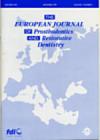European Journal of Prosthodontics and Restorative Dentistry

- Cover Date:
- March 2006
- Print ISSN:
- 0965-7452
- Vol:
- 14
- Issue:
- 1
Recording surface detail on moist surfaces with elastomeric impression materials
Abstract - The objective was to assess the ability to accurately record detail on moist surfaces for three elastomeric impression materials derived from different polymers. One polyvinylsiloxane, one polyether and one hybrid material containing a copolymer of siloxane and polyether polymers were used. Impressions were recorded of moist gypsum casts having both a shallow (~ 20 µm) and deep (~ 180 µm) groove reproduced on their surface. The grooves in the casts and in the impressions were proï¬led using a non-contacting laser proï¬lometer. Comparisons were made between the groove depths in the casts and impressions (paired t-test). The results indicated that all of the tested materials accurately recorded dimensions in the x-y plane. However, there was evidence that the polyether and hybrid materials were more accurate than the polyvinylsiloxane in recording the true depths of the deep grooves (z plane) under moist conditions. It was concluded that the more hydrophilic nature of the polyether and hybrid materials enabled them to record more accurate impressions of moist surfaces, particularly in areas of difï¬cult access as modelled by the deep grooves.
KEY WORDS: elastomers, dental impressions, polyvinylsiloxanes, polyethers, detail reproduction
- Article Price
- £15.00
- Institution Article Price
- £
- Page Start
- 42
- Page End
- 46
- Authors
- J.F. McCabe, T.E. Carrick
Articles from this issue
- Title
- Pg. Start
- Pg. End
- Effect of Five Staining Solutions on the Colour Stability of Two Acrylics and Three Composite Resins Based Provisional Restorations
- 2
- 6
- Surface Microhardness of a Resin Composite: a Comparison of a Tungsten Halogen and a LED Light Curing Unit, in vitro
- 7
- 12
- The effect of cooking method upon the titratable acidity of a popular vegetarian dish – Scope for reducing its erosive potential?
- 28
- 31
